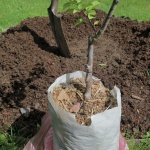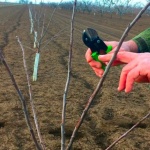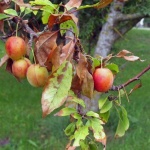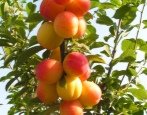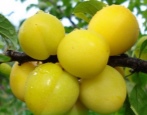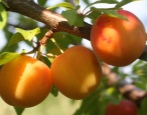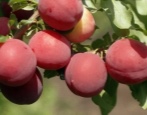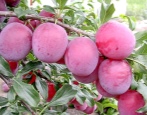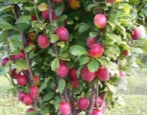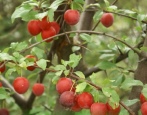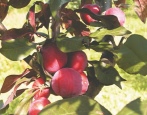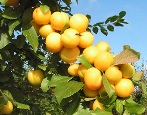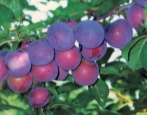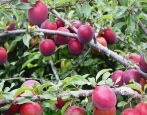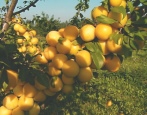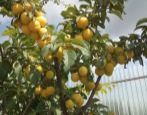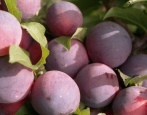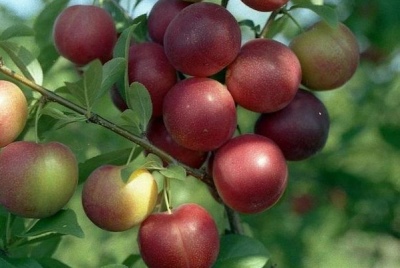
- Authors: G.V. Eremin, L.E. Velenchuk
- Year of approval: 1986
- Growth type: medium-sized
- Ripening period: early
- Self-fertility: self-infertile
- Fruit size: medium size
- Yield: high
- Appointment: universal
- Fruit weight, g: 18,5
- Fruit shape: flat-round, unequal
Cherry plum is a popular fruit tree, but it also has high maintenance requirements. There are not so many unpretentious varieties, one of them is the Traveler. Any summer resident will definitely cope with the cultivation of this variety.
Breeding history
The development of the Traveler took place at the Crimean experimental selection station of the Vavilov All-Russian Research Institute of Plant Industry. Such employees of the enterprise as Eremin and Velenchuk took part in it. To obtain the Traveler, two other varieties were taken: Tavricheskaya cherry plum and Burbank Chinese plum. The new culture was allowed to be used in 1986.
Description of the variety
Fruit culture Traveler has an average height of 3-3.5 meters, but many trees grow up to 400 cm. The crown of medium-sized trees is broadly oval, moderate thickening. The stem of the plant is not too large, covered with gray smooth bark, on which there are many lentils.
Shoots of the Traveler are of the cranked type. They are quite thick and straight, covered with brownish-green bark. Spears have a short lifespan, they are mostly elongated. The buds have an oval shape and a sharp top, when they open, they turn green.
The foliage is quite large, oval in shape. The growth of green leaf plates is directed upwards. The top is sharp, and the base is in the shape of an arc. The leaves are glossy, without fibers, they are smooth on the top and a weak downy down. The edges of the plates have a slight waviness.
The inflorescences of the Traveler are usually two-flowered. The flowers are large in size, painted white. The petals are weakly closed, their shape is oval.
Gardeners noted the following advantages of the Traveler variety:
universal purpose of fruits;
high yield rates;
good taste and aroma of fruits;
high winter hardiness;
decent resistance to fungal diseases;
early ripening;
stable fruiting.
The cons will be as follows:
the fruits are not too large, and the stone is removed with difficulty;
the plant needs pollinators;
fruits lie extremely poorly, and it is very difficult to transport them;
the tree does not withstand arid and overly hot weather.
Fruit characteristics
The Traveler's fruits are not large in size. Usually the size of the fruit is 2.9x3x2.8 cm. The average weight, according to the register, is 18.5 g, but in practice it often reaches 28. The shape of the fruit is flat-round, symmetry is not traced in them. The base of the fruit is widest.
The harvested crop has a dark red shiny skin. It is quite dense, has an average thickness. Tearing it off the pulp is almost impossible. And also it is covered in large quantities with yellow subcutaneous points. The middle abdominal suture is immediately visible. There is a waxy coating, but it is rather weak.
The pulp is fibrous in consistency, with good juiciness. Has an orange color scheme. The size of the stone is medium, and it is impossible to separate it from the pulp.
Taste qualities
Cherry plum Traveler is a rather fragrant variety.The palate has an optimal balance of sweetness and acidity, but for the most part, the fruits are still sweet. When tasting, the variety was rated at 4.2 points on a 5-point scale.
Ripening and fruiting
In most of the territory of Russia, the Traveler begins to bloom in the 2nd decade of April. If the spring is cold, then the appearance of flowers may be delayed for a couple of weeks. The fruits appear in early June. In terms of ripening, this is an early culture. Another plus of the variety is regular fruiting. The traveler bears fruit very steadily, without years of rest.
Yield
Fruiting in the variety is long, so the fruits will not ripen all at once. Ripe ones must be picked immediately, as they can quickly turn into carrion. An adult Traveler tree yields 35 to 40 kilograms of fruit. This is a high figure, but it is quite real, since there are a lot of ovaries, and the fruits are relatively small. As for the industrial scale, the average collection per hectare of soil is 501.4 centners.
Growing regions
The originators declared the following regions of growth that are optimal for the culture:
Central;
TsCHO;
North Caucasus;
Northwest region.
Self-fertility and the need for pollinators
Without additional sources of pollination, the Traveler will simply not bear fruit. At the same time, it is useless to use a home plum, pollination will not occur. But the Chinese varieties of plums will allow you to get a rich harvest.
Growing and care
The traveler is most often planted in the spring, until the buds have blossomed. Autumn planting is permissible only in regions with a warm climate, while the time must be adjusted so that at least 60 days remain before frost. This variety is planted exclusively in the sun. There should be some kind of protective structure nearby to protect the seedling from piercing winds. The minimum depth of groundwater is 1 meter.
The Traveler's pits are prepared 14 days before landing. Fertilizers are required in them. They take humus and compost, mix it with wood ash and minerals. As the latter, superphosphate (50 g) and potassium salt (60 g) are especially recommended. The soil should not be acidic, therefore, if it is exactly like this on the site, it should be compulsorily calcareous.
Important: to take for planting is only the seedling that was already initially grown in this region. Otherwise, the chances of survival are very low.
Once planted, the Traveler's seedlings will need some maintenance. These are the following important points.
Watering. For him, grooves are made next to the tree. Water will have to be poured there. The variety does not tolerate drought, but too moist soil is harmful to it. To check the moisture level, you can hammer a thin piece of reinforcement 0.3 m long next to the tree.If it is dry after taking it out, it's time to water. Young trees need 1-2 buckets, but every year this number is increased by 1 unit.
Loosening. The Traveler's trunk circle must be loosened at least a couple of times per season. And also this place should be cleared of weeds. Mulching is optional, but it can be a great help if you need to contain moisture.
Top dressing. Be careful here, especially with nitrogen. You cannot give a lot of this substance. But the Traveler perceives foliar mineral dressing very well. Their trees are held in May and early summer.
Pruning. In the south, the cherry plum crown of the described variety has a sparse-tiered shape. But in the middle lane, a leaderless formation is optimal (a bowl without a central conductor). Trees grow very quickly, so the shoots will need to be pruned regularly.
Disease prevention. The traveler rarely gets sick, but it still happens. In order to prevent the spread of the infection, in the spring the trees are sprayed with Bordeaux liquid (1%). Pests are immediately disposed of with insecticides.
Wintering. Young trees need to be covered for the winter. Before this, the obligatory whitewashing of the trunks is performed. Plants are covered with spruce branches and burlap, and protective nets from mice are placed.As soon as the first snow falls, it is immediately shoveled to the side in order to ensure high-quality freezing of the soil. And when spring comes, and the snow begins to melt, be sure to dig grooves nearby so that the melted water has a place to drain.
